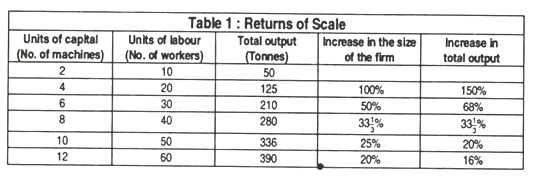In this article we will discuss about scale of production in economics. Also learn about the economies of scale.
This is an age of large-scale production. And the present system of production is based on division of labour and specialisation.
In any discussion of production theory and production process, we draw a distinction between the short run and long run. It is assumed that in the short run some of the resources used in the production process remain constant (i.e., fixed in supply).
This is why when there is an increase in the supply (usage) of one factor, say labour, output increases no doubt but not proportionately and the phenomenon of diminishing returns is encountered In the long run, however, it is possible for a firm to vary the quantities of all factors of production. More land can be acquired, new factory and office buildings can be constructed and more machinery acquired and installed. It is even possible to change the size of the plant or factory in the long run.
ADVERTISEMENTS:
In short in the long run it is possible for a firm (or a producing unit) to change the scale of its operation or its size and the level of activity. In the true sense a change in the scale (of production) takes place when the quantities of all the factors are changed by the same percentage so that the proportions in which they are combined remain unchanged.
It may apparently seem that when all inputs are changed proportionately there is a proportionate change in output. But, in reality, this does not happen. A feature of any production system (process) is that, when there is a change in the scale of production there is not necessarily (usually) proportionate change in output. When the size of a firm gets doubled, output may get more than doubled, exactly doubled or less than doubled.
We use the term returns to scale to refer to the relationship between change in scale of production (or size of the firm, measured in terms of the quantities of factors used) and the resultant changes in output. This important concept is illustrated in Table 1.
The firm increases in size but the factor proportion (i.e., capital-labour ratio) remains unchanged (i.e., 1 unit of capital per 5 units of labour).
ADVERTISEMENTS:
In the last two columns of Table 1 we make a comparison between the proportionate changes in total output with the proportionate changes in the size of the firm (or its scale of operations). As the size of the firm increases from 2 machines and 10 workers to 6 machines and 30 workers, it experiences increasing returns to scale (output increases more than proportionately).
A change in scale from 6 machines and 30 workers to 8 machines and 40 workers yields constant return to scale (firm size and the volume of output change by the same percentage). Any further increase in the size of the firm yields decreasing returns to scale, i.e., output increases less than proportionately. In Table 1 when the size of the firm increases by 25% output-increases by 20% and when the size increases by 20% output increases by 16%.
Those features of large-scale production (i.e., increasing size) which account for increasing returns to scale (i.e., more than proportionate increase in output) are usually described as economies of scale. Likewise, the causes of falling efficiency as the size of the firm increases are described as diseconomies of scale.
ADVERTISEMENTS:
The economies of scale are the advantages of large-scale production and the diseconomies are the disadvantages. Alfred Marshall divided these economies and diseconomies into two broad categories, viz., internal and external.
Economies of scale exist when expansion of the scale of production capacity of a firm or industry causes total production costs to increase less than proportionately with output. As a result long-run average costs of production fall.
Economies of scale are generally classified as:
(a) Internal Economies:
These occur as a result of the expansion of the individual firm independently of changes in size of the other firms in the industry. As G. F. Stanlake has put it, “Internal economies of scale are those which arise from the growth of the firm independently of what is happening to other firms. They are not due to any increase in monopoly power or to any technological innovation; they arise quite simple from an increase in the scale of production in the firm itself”.
(b) External Economies:
These exist if the expansion in scale of the whole industry or group of firms results in a fall in the costs of each individual firm. In the words of Stan lake, “external economies of scale are those advantages in the form of lower average costs which a firm gains from the growth of the industry. These economies accrue to all firms in the industry independently of changes in the scales of individual outputs.”
